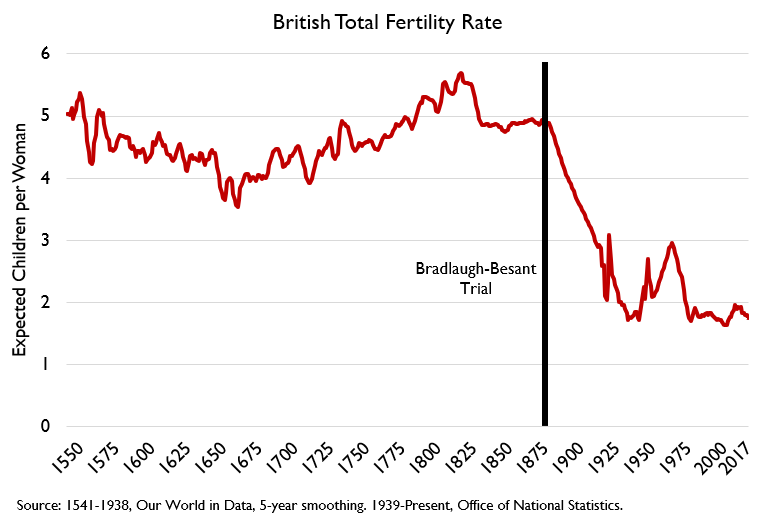Over the course of the nineteenth and twentieth centuries, something remarkable happened: people started having fewer children. Way fewer. In country after country, fertility rates fell from four to eight children per woman to less than three, and in many cases less than two.
What caused this decline in fertility? Did changes in child mortality and life expectancy cause parents to desire fewer conceptions? Did increased return to human capital change the optimal child-rearing strategy? Was the decline caused by increasing exposure to the toxic chemical mix of industrialization?
The above explanations, and many others, have been proposed at various times by biologists, economists, and sociologists. But a growing body of economic research is offering a decidedly anthropological explanation for fertility: it’s about culture. People have the children they have not simply due to their individual pursuit of happiness, economic returns, or mere biology, but because of how cultural and values systems shape their behaviors.
It’s easy to spot culture-fertility linkages “in the wild.” For example, in ethnically Chinese populations around the world, birth rates spike in lucky Zodiac years, like the Dragon year. Births fall sharply around major holidays in virtually all countries. In America, they also fall sharply on unlucky days like April 1 or Friday the 13th. I’ve catalogued these and many more cultural-fertility interactions elsewhere.
Start your day with Public Discourse
Sign up and get our daily essays sent straight to your inbox.But can cultural factors explain big changes in fertility? Sure, maybe a change in cultural values can nudge when a couple has a baby by a little bit here or there, or maybe we can change the pace of change in birth rates a bit. But could an arbitrary shock to social values really trigger an epochal shift in demographics like that observed during the so-called “demographic transition?” New research by Brian Beach and W. Walker Hanlon says yes.
Public Outrage—Public Education
In 1877, a pair of contraceptive advocates named Charles Bradlaugh and Annie Besant published a book by an early American birth-control proponent named Charles Knowlton. This violated Britain’s then-strict censorship laws, which prohibited spreading information about contraception, and provoked one of the highest-profile court dramas of the late nineteenth century. Within a year of the trial, Britain’s previously stable fertility rate had begun to tumble.

The study’s authors show that this decline wasn’t random: it was most severe, and started earliest, in those English districts where the newspapers gave the most attention to the Bradlaugh-Besant trial. More media coverage of the trial meant faster fertility decline, despite the fact that virtually none of the media coverage included any discussion of actual birth-control methods. Indeed, the main methods of birth control advised by the pamphlet didn’t actually have much scientific validity. In other words, the pamphlet didn’t really improve scientific literacy about birth control, it just changed what things people felt comfortable talking about.
By publicizing the controversy, the mass media of the day made a formerly “obscene” topic normal conversation. People could suddenly talk about birth control and fertility limitation. Even if the specific contraceptive methods being publicized didn’t work, people understood the mechanics of how babies are made, and they could use various strategies to avoid conceiving. Concurrent with the public trial, a group called the “Malthusian Society” formed: it was the first organized, public, family-planning organization in Britain, and it had the explicit mission of curtailing population growth. This was all a major cultural change: before the Bradlaugh-Besant trial, public discussion in Britain assumed that women had no moral right to exercise control over their fertility. It was simply a natural phenomenon, ordained by nature’s God.
But the authors don’t stop at demonstrating the effect of the Bradlaugh-Besant trial within England. They go further. They show that it had spillovers: among Anglophone settlers in Canada, who had sudden, sharp declines in fertility versus their Francophone neighbors; among Anglophone settlers in South Africa, who saw big fertility declines versus their Dutch-speaking Boer neighbors; among recent British immigrants to the United States, who saw sharper fertility declines than the rest of the country; and even in Australia, where fertility rates took a sudden nose dive. In fact, the Bradlaugh-Besant trial had cultural spillovers wherever it made headlines, which basically meant anywhere in the British empire where there were people reading English-language newspapers. Of course, it was just one of many birth control controversies around the world in the nineteenth and twentieth centuries, with similar dynamics playing out time and again: activists make a push for a change to fertility norms, the public responds with outrage, but the Overton Window of acceptable discourse shifts—indeed, it shifts at least in part because of conservative reactions.
At least in the British case, it seems quite clear that demographic transition was directly triggered by a specific cultural event: a high-profile court case that called into question cultural norms about whether people had a right to manage and control their own fertility.
A Revolution of Ideas
That economic paper isn’t the only one showing how people develop their fertility preferences. Another recent study by Guillaume Blanc and Romain Wacziarg looked at this question in a different way. Instead of looking at one discrete event, this study provided a detailed economic and historical account of the French village of Saint-Germain-d’Anxure.
France experienced its demographic transition long before most of the rest of the world, an anomaly that has attracted research attention for many years. By looking in great detail at one community for which an enormous amount of detail is available (thanks in part to church records of births, marriages, and deaths), some important questions can be sussed out. For example, from 1730 to 1895, what caused fertility to decline in Saint-Germain-d’Anxure? Was it caused by a shift toward industrial work away from agriculture? Was it caused by more education for women? Was it caused by a change in values? By looking in detail at how all of these factors changed over time, the authors can answer those questions.
Their answer is striking: fertility fell before child mortality declined very much, before literacy rose, before agriculture employment fell, before any change in economic mobility had set in. None of the conventional explanations for causes of fertility declines explain case of Saint-Germain-d’Anxure. Rather, the most likely explanation relates to cultural values: fertility fell by one whole child per woman between 1787 and 1815, for example. Before that revolutionary period, fertility had been gradually declining, but had remained mostly stable. And after 1815, fertility bounced back up . . . until the revolutionary dislocations of 1848 and the beginning of the Second Empire under Napoleon III, when fertility fell again.
In other words, political conditions, the spread of specific ideologies, and changes in social and cultural attitudes probably mattered as much or more than specific economic conditions. As in Britain in 1877, so in eighteenth- and nineteenth-century France. The advent of demographic transition from high to low fertility can be better explained through reference to shifts in culture and values than changes in economic conditions.
Demographic transition from high to low fertility can be better explained through reference to shifts in culture and values than changes in economic conditions.
Fertility Preferences Today
Finally, there is considerable research on what drives fertility preferences today. Many surveys measure fertility preferences in different ways: men and women are asked about their intentions, plans, desires, preferences, ideals, wishes . . . all sorts of different terms. But extensive research has found that the most stable question is about ideals. Asking people about their childbearing intentions tends to be very volatile: short-term economic and relationship changes can have very big effects on how they respond. But asking about ideals yields more consistent answers, and it cuts to the core of cultural values.
So what makes people likely to prefer more children? Religiosity is certainly a factor. But ethnic differences not directly tied to religion probably matter as well. Growing up in a community surrounded by extended families and people who support your way of life seems to boost fertility as well. This finding has been duplicated among the Roma in eastern Europe, immigrants in France, ethnic minorities in Indonesia, and African-Americans in the United States. Growing up in an environment that encourages connection to extended family and a sense of ethnic or cultural identity helps transmit fertility ideals, norms, and behaviors. Put simply, there is robust empirical evidence that people “learn” fertility ideals from their parents and immediate communities.
But it’s not just traditional communities. Modern mass media can be just as influential as the newspapers of Britain in the 1870s. Soap operas in Brazil and 16 and Pregnant in America have both caused measurable changes in fertility behaviors in recent years. The cultural environment continues to influence fertility, whether through ethnic identification, family ties, or media consumption. Obviously, cultural norms related to timing of marriage and childbearing could matter as well.
Recent research suggests that some of the recovery of fertility in Eastern Europe in recent years may be due to a “retraditionalization” of values. Basically, as Eastern Europe has broken from the expected path of progressive change toward secularism and individuality, its fertility rate has risen. Attitudes and values matter. In the case of much of Eastern Europe, this change in values has been accompanied by changes in religious belief and practice, with public religion returning after decades of Soviet repression. The end of state-enforced secularism has led directly to more religious belief and expression, and thus more traditional values. Via that channel, there has been a recovery in fertility.
As Eastern Europe has broken from the expected path of progressive change toward secularism and individuality, its fertility rate has risen.
Culture Wars
While this question may seem like historical pedantry, it turns out to be politically significant today. Wealthy Western donors in the former colonial metropoles like France, Britain, or the United States spend billions of dollars on demographically targeted programs in the developing world. The conceit of these programs is that they fulfill an “unmet need” for contraception in developing countries. That is, they are justified by claiming that economic changes drive a reduction in fertility preferences in the population, and to help women achieve those preferences, Western donors should shell out for condoms, pills, and abortions. Never mind that studies consistently show that women in developing countries actually desire to have lots of children: Western donors know best.
But if demographic transition is driven in large part by shocks to culture and values, and less by health or economic factors, then the entire justifying argument for these programs falls apart. If, in fact, decline in fertility preferences is not caused simply by the natural change in economic conditions, but by discrete cultural events that destroy previously existing cultural norms and create new ones, then the whole project of Western-funded family planning operations is nothing other than cultural colonialism. It is France exporting its revolutionary ideals via the old ties of colonial dependence; it is Britain exporting the controversies of the Bradlaugh-Besant trial to the countries Britain dominated for generations.
Put plainly, if the demographic transition is in large part about a change in values, then it must be understood as a fundamentally political, values-laden project, which individuals and countries may have an interest in resisting or opposing. If fertility declines because child mortality is falling, then almost any moral system would encourage most people to accept the trade-off. But if fertility is falling because Western countries promote a set of cultural narratives telling women in Africa, Asia, and Latin America that children are antithetical to a happy life, that the ways of life of their national communities are outdated and backwards, and that cultural legitimacy comes from emulating the family patterns of white Westerners, then there may be strong reasons to reject this model.
In reality, both forces are at work. There is extensive research showing that reductions in child mortality alongside economic modernization do reduce fertility and fertility preferences, even without changes in education, religiosity, or democratization. But when former colonizers intervene in the countries they used to dominate, they should keep in mind that fertility reduction is not only about these incontrovertible goods: it is also, to a quite meaningful extent, a project of cultural revision that locals may be quite justified in resisting.














